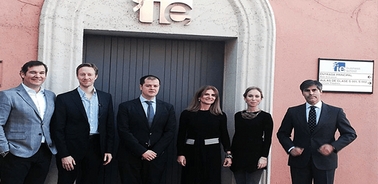- Home
- News And Events
- What’s Going On
- Ie And Mastercard Report On High-value City Tourism
IE and MasterCard Report on High-Value City Tourism

IE and MasterCard Report on High-Value City Tourism reveals increase in levels of bleisure, pre-booking of activities and services, and tourists using mobile connections.
City travel worldwide has grown by 60% over the last 5 years, a far faster pace than sun and beach tourism, according the findings of the report on Key Drivers Behind High Value City Travel drafted by the IE and MasterCard Observatory on Premium Markets and Prestige Products. The report reveals pivotal factors for premium urban tourism, and finds that two out of three people who travel for business organize their trip so that they can enjoy their destination as a tourist. Bleisure, namely the act of combining business travel and leisure pursuits, is more widespread than expected. Some 58% of frequent business travelers add a day or several days to their business trips in order to explore the city in their own time. Due to time limits or incentives to visit the city in question, which may include guided visits, the most preferred amount of time spent on such visits tends to vary. Making purchases is very popular among bleisure tourists, for example, with shopping in the city being far more popular than buying at the airport or duty-free shops.
The report on High-Value City Tourism is based on 1,500 interviews conducted in selected countries of traveler origin, namely the US, the UK, Russia, Latin America and Spain. The research project was extensive, and included the opinions of a panel of experts from the hotel, gastronomy, culture, and luxury product sectors, and media organizations focused on the travel sector. They concurred that high-value city tourism is an excellent opportunity for Spain’s two main cities: Madrid and Barcelona.
“Tourism makes up 9% of the world’s GDP and jobs,” says María Eugenia Girón, director of the IE Business School and MasterCard Observatory on the Premium Market and Prestige Products. “The number of travelers is expected to almost double by the year 2030. The Report on High-Value City Tourism reveals changes that are taking place in the preferences of premium travelers, and how the growth of urban tourism brings enormous opportunities for Spain. Madrid and Barcelona can improve their competitive advantages, particularly for travelers that bring the greatest levels of added value.”
The findings of the report point to pre-booking activities and services being an interesting option for travelers, and that this is changing the rules of the game in the travel sector. Booking flights and hotels from home has long been standard practice, and now the same is starting to apply to leisure activities in the city of destination, thanks to changes that are breaking with traditional practices. Three out of four travelers say that they occasionally book activities and services before leaving home. “Of those who don’t, some 40% would prefer to book in advance if they knew they could find good offers for city experiences, which is a source of information just asking to be tapped by local operators,” says tourism consultant Jörn Gieschen, who headed IE’s report.
Fifty percent of travelers currently use their smartphone in the streets of the cities they visit, thanks to better coverage and falling prices. Moreover, websites for mobile phones have improved greatly and innovative travel apps have entered the market. Fifty percent of travelers often use their mobile phones to guide them around cities when abroad. Among Russians the figure reaches 65%. The younger the segment, the greater the level of smartphone use, but even among travelers aged between 36 and 55 years of age, the average level of use stands at 40%.
Purchases, sports events, culture and entertainment are key for the city of Madrid, while Barcelona stands out for its natural environment and tourist locations, night life and excursions, according to the findings of the report. Both Madrid and Barcelona enjoy a good brand image. Barcelona is considered the fourth most attractive city in Europe, after Rome, Paris and London. Madrid comes in seventh place behind Prague and Vienna, but ahead of cities like Amsterdam, Milan, Berlin, Budapest and Istanbul. The ranking of Spain’s two major cities is very similar within the markets studied – they only start to look a little weaker when ranked against cities in the US. Both cities are seen as having the wow factor, which means that they receive even better qualifications from people who have already visited them. The architecture and monuments, local gastronomy and culture, and museums and art galleries, are the most valued categories.